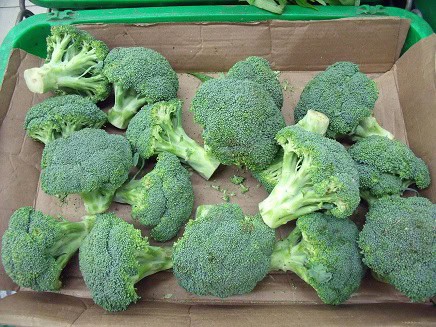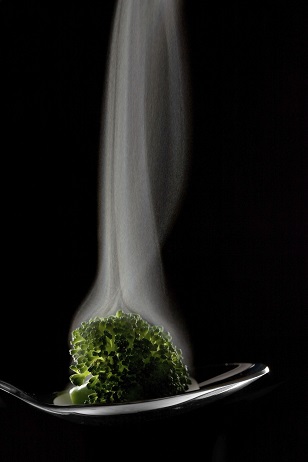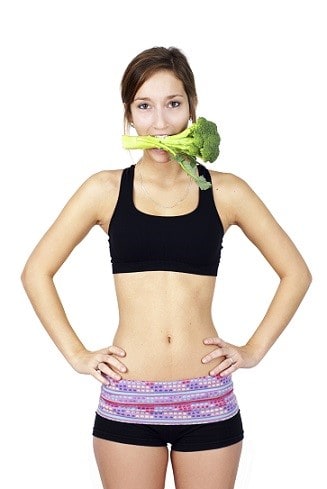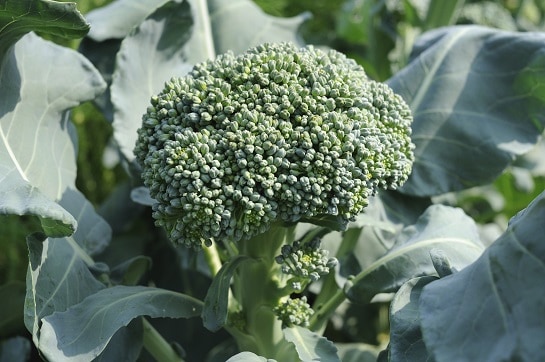 Broccoli is already an excellent food for acne, as is its relative cabbage. Both contain over 50% of the RDI for vitamin C per 100 grams, and magnesium as a bonus. Both are anti-inflammatory, and including just one in your daily diet (broccoli tastes better) will bring the entire immune system stimulation behind your acne down a notch.
Broccoli is already an excellent food for acne, as is its relative cabbage. Both contain over 50% of the RDI for vitamin C per 100 grams, and magnesium as a bonus. Both are anti-inflammatory, and including just one in your daily diet (broccoli tastes better) will bring the entire immune system stimulation behind your acne down a notch.
But there’s one compound found in broccoli and cabbage, and in lesser levels in other cruciferous vegetables, which really makes them outstanding for acne. This compound hasn’t been neglected by scientists; it’s one they’re utterly obsessed with, and for good reason. This compound is sulphoraphane.
Broccoli and cabbage’s super compound
Sulphoraphane was first discovered in red cabbage in the mid-20th century, and finally isolated from broccoli in 1992. Since then, scientists have been buried under an avalanche of research papers. More than 3000 studies on sulphoraphane have been conducted on rodents alone. Sulphoraphane is particularly abundant in young tender stem broccoli, but luckily for us consumers, adult broccoli contains plenty as well.
Actually, that’s misleading: in intact broccoli, i.e. the raw broccoli bought from a supermarket, there’s very little sulphoraphane at all. Instead, it’s mostly bound up in a precursor called glucoraphanin.
Broccoli also contains an enzyme called myrosinase, which is separated from glucoraphanin by cell walls. Once the broccoli plant is damaged in any way, such as chewing or cutting, the myrosinase is released, and transforms the freshly released glucoraphanin into various by-products. The most bioactive one produced is sulphoraphane, often in a copious flood.
All this happens while on your plate, and in your stomach. It’s very similar to garlic with its health-giving allicin, which is only produced after being cut on a chopping board, when its aliin and allinase enzyme are released to interact.
The glucoraphanins in broccoli are also converted to sulphoraphane by gut bacteria. Humans and other mammals produce no myrosinase enzymes themselves, but our friendly microorganisms like bifidobacterium longum do.
In any case, feast on broccoli and cabbage, and sulphoraphane will flow through your veins within 30-60 minutes. Its first acne benefit is the bread and butter of slashing inflammation. Sulphoraphane is extremely powerful at extinguishing the fires of your immune system, including those that assault bacteria in your skin pores and create a pimple. There’s far too many studies to list, but there’s reductions in inflammatory actors linked to acne like TNF-a, Nf-KappaB, interleukin-8, Il-6 and Il-1beta. Sulphoraphane can increase the anti-inflammatory interleukin-10.
One standout is the effect on neutrophils, immune system actors which release bursts of free radicals to break down damaged tissue. This often goes way too far and inflames healthy cells, but according to a 2023 study, sulphoraphane reduces the quantities of free radicals produced by individual neutrophils, making them less aggressive.
Muffles alcohol’s acne dangers
 The vitamin C and magnesium in broccoli are decently protective, but sulphoraphane is the reason why a fresh plateful can also be a hangover cure. It’s a fully scientifically backed hangover cure, rather than one insisted upon by drunken university friends (though some of those might be accurate too).
The vitamin C and magnesium in broccoli are decently protective, but sulphoraphane is the reason why a fresh plateful can also be a hangover cure. It’s a fully scientifically backed hangover cure, rather than one insisted upon by drunken university friends (though some of those might be accurate too).
In fact, broccoli and its sulphoraphane might prevent a hangover altogether. The reason is that sulphoraphane increases the potency of the aldehyde dehydrogenase (ALDH) enzymes, produced in human tissues. What does this mean? ALDH is the enzyme that detoxifies acetaldehyde, the main toxic by-product of all alcohol, whether it’s in beer, wine or spirits.
There’s a condition known as the “Asian flush reaction” where drinking alcohol causes a wave of redness to spread up the back, neck and face. It’s named thus because it’s especially common east Asians, in China, Japan and Korean.
People in these regions have a 20-30% occurrence of ALDH2*2 , a genetic allele which vastly reduces production of the ALDH enzyme. These unlucky people can barely drink one glass of wine without changing colour, or getting a pounding heartbeat. Inuits also have faulty ALDH genes. It’s believed that such genes explain why alcoholic beverages became less culturally popular in east Asia compared to say, Latvia (Europe’s official drunkenness capital).
Anyway, the scientists were thinking of these east Asians in 2013 when they tested the broccoli compound on rabbits, for 7 days prior to feeding them ethanol. This was preventative, not post alcohol – it could act as a shield. The sulphoraphane treatment not only enhanced the potency of the ALDH enzyme, but the actual clearance of acetaldehyde from the bloodstream, fully doubling the rate.
In 2016, research advanced to the next level by moving onto humans. It tested saliva – whether sulphoraphane could increase the alcohol-detoxifying enzymes flowing around your mouth (sounds cool). Indeed, various cruciferous vegetables increased the ALDH enzyme. Radish, turnip and cauliflower performed admirably, but broccoli and cabbage performed the best, and these are richest in sulphoraphane.
Isolated sulphoraphane was tested, and found to bind directly to the ALDH enzyme molecule. It did so without disrupting its structure, and once in place, it increased the affinity of the enzyme for acetaldehyde molecules.
None of this disrupts the pleasure of alcohol – the fine taste of wine, or the drunken escapades, whichever it is you seek. ALDH accelerates the reduction in alcohol’s toxic by-products, and not alcohol itself.
Two studies and a remedy is respected, but with 3 studies its greatness is sealed. That came true for sulphoraphane in 2020, when it was again tested on the ALDH enzyme, but this time in the liver. A large increase in ALDH was detected in human hepatic cells, but it also suppressed the rise in human LX-2 cells caused by acetaldehyde. These are primary cells responsible for liver fibrosis.
If sulphoraphane defends your liver against alcoholic bombardment, then protecting your skin should be no problem. As we’ve discussed here, the main acne danger of alcohol and its acetaldehyde by-product is glutathione depletion (a powerful antioxidant), plus bonus direct inflammation.
Unleashes your own antioxidant potential
Sulphoraphane has very little antioxidant capability of its own, the ability to charge down and deactivate free radicals. It lacks the direct powers of the purple anthocyanins in pomegranate, or the epicatechin in dark chocolate.
But sulphoraphane is one of the greatest compounds in fruits and vegetables for supercharging your own antioxidant production. It’s a definite candidate for the greatest of all, as it flips a simple switch known as NRF2. This is like a master regulator for all self-manufactured antioxidants, a master gene controlling secondary genes downstream, which themselves control glutathione, superoxide dismutase, and catalase (all beneficial for acne). NRF2 even has bonus benefits for cancer prevention, as it increases free radical generation in cancer cells, the one place we want them, as this causes the cells to undergo apoptosis (self-destruction).
Sulphoraphane is proven to increase NRF2, but also the antioxidants themselves, completing the connection. For example, one study that sulphoraphane reverses the decreased glutathione caused by elevated neutrophils, which are the main reason why the psychoactive medication lithium cause acne. A 2018 study found that glutathione levels rose in the brain after 7 days of sulphoraphane administration in humans.
Sulphoraphane actually has evidence for improving a variety of mental conditions, like depression, the memory loss of dementia, and even psychosis. But that’s a whole other topic – what we now know is that sulphoraphane stimulates an antioxidant which acne patients have 20% less of (study). That’s without mentioning superoxide dismutase and catalase. The latter is actually a pathway in alcohol detoxification itself.
An all-purpose chemical shield
 Alcohol is just the tip of the iceberg with this broccoli compound. Protecting against harsh chemicals seems to be a speciality of sulphoraphane, including ones that unlike alcohol, have no advantage whatsoever. Most of these chemicals rob your body of antioxidants needed to clear acne, and crank up the chronic inflammation that causes it.
Alcohol is just the tip of the iceberg with this broccoli compound. Protecting against harsh chemicals seems to be a speciality of sulphoraphane, including ones that unlike alcohol, have no advantage whatsoever. Most of these chemicals rob your body of antioxidants needed to clear acne, and crank up the chronic inflammation that causes it.
One is BPA, found in the lining of old pipes, tin cans, and paper receipts. In human liver cells and live mice, sulphoraphane protected against its toxic effects. Numerous heavy metals have been tested, including arsenic, often found in apple juice and rice, and therefore annoying for any acne patients hoping to eat them. In rats, sulphoraphane protected against the kidney toxicity of arsenic, and best for acne patients, the surge in free radicals. A second study by the same team tested the livers of rats instead. Again, sulphoraphane muffled the free radical mayhem unleashed by arsenic. The protection is consistent across multiple organs, and the skin is also an organ.
Aluminium was next to be knocked over like a domino. This is the heavy metal which contaminates deodorants and poor quality tap water. Sulphoraphane counteracted the antioxidant depletion it unleashed, and also the reductions in sperm count and mobility, and hormonal destabilisation.
Any heavy metals we’ve missed? Yes, as sulphoraphane doesn’t ignore cadmium, a by-product of industrial usage which is pumped out in mining and smelting and belching factory fumes. It also enters crop fields soil via phosphate fertilisers, where it causes antioxidant depletion in people who eat the vegetables grown there, but sulphoraphane combatted this, according to a study on mouse liver cells. A spike in pro-inflammatory markers in the liver was also combatted (great for acne when on the skin). Cadmium was even found in jewelry and plastics until the EU banned it in 2011.
There’s no need to have these monstrosities in the human body, but being realistic, even people who take precautionary steps will have a small intake. You’re equipped to metabolise slight intakes – that’s what your detoxification systems are for – but sulphoraphane will make the impact on your acne non-existent. Maybe cigarette smoke will be next to be tested, which would be great for people who can’t avoid walking through clouds of second-hand smoke wafting around in the bus stop or underground train station.
The secret connection to gut health!
The fact that sulphoraphane is generated by myrosinase enzymes, rather than existing in the raw broccoli plant, means that your gut bacteria quality affects how much you benefit.
If you combine natural bio-live yogurt with broccoli for lunch each day, then that broccoli will have double the benefits. Even better, if you eat obscure bioactive prebiotic foods like sauerkraut and real soy sauce. The less you abuse sugar (which fuels malicious bacteria strains), the more powerful broccoli and its sulphoraphane may be.
Take a look at this study. Few broccoli fanatics know about this. Magazines don’t mention it. It found that in human beings, the sulphoraphane generation after raw broccoli was crippled after adding antibiotics to the equation.
According to them: “the conversion of glucosinolates became negligible“. This is because antibiotics decimate the malicious pathogens they’re intended to, but also wipe out friendly strains indiscriminately, removing the converting enzymes they produce. This is yet another reason to reject oral antibiotics for acne, such as doxycycline. Natural diet strategies like green vegetables will become weaker than they should.
Of course, the opposite can also happen. Scientists once gathered mice and flooded their colon with higher levels of gut bacteria. The result was generation of sulphoraphane from glucoraphanin rising from a steady flow to a dam-bursting torrent.
Varying contents, but nearly always strong
 Glucoraphanin, the precursor to sulphoraphane, is a type of glucosinolate. It’s believed that its role in wild brassica family plants is defense against disease, as the resistance of individual plant’s to pathogens correlates closely with the content. It’s the broccoli plant’s natural firewall, like the human immune system. They’re also a defense against various environmental threats like drought, extreme temperatures and nutrient deprivation.
Glucoraphanin, the precursor to sulphoraphane, is a type of glucosinolate. It’s believed that its role in wild brassica family plants is defense against disease, as the resistance of individual plant’s to pathogens correlates closely with the content. It’s the broccoli plant’s natural firewall, like the human immune system. They’re also a defense against various environmental threats like drought, extreme temperatures and nutrient deprivation.
The key evidence is that in cultivated brassica plants, which are protected by the loving hand of farmers, the glucosinsolate content is decreased (though still at strong levels). This also means that organic broccoli contains more glucoraphanins, as they must be completely self-reliant. This was shown in a 2023 study which collected broccoli from four fields in northern Spain, two conventional and two organic. The same organic boost has been found in studies on cabbage. I’d still recommend non-organic broccoli unless you’re really rich (I don’t bother buying it organically), but here’s another fact to add to your acne databanks.
Broccoli fanatics have also roamed the wild country, and found broccoli relatives (Brassica villosa from Sicily) with a freakishly high glucoraphanin content. They’ve used these to breed new broccoli forms which maintain these super high contents, which should translate to higher sulphoraphane generation. Super broccoli may be coming to a store near you soon. For now though, normal broccoli will easily suffice, whether for destroying acne or gaining energy and fitness.
The good news is that sulphorphane/glucoraphoranin is most abundant exactly where we want it to be – the broccoli florets and especially the buds (the tiny dark green right at the end).
Even regular broccoli has wildly fluctuating contents. It might be pure luck whether the broccoli you buy one day is an outstanding acne antidote or merely great. Scientists roamed around Baltimore stores and purchased 31 different samples of broccoli – this mimics the broccoli ordinary people might absentmindedly drop into their trolley. They found a huge range of glucosinolate content from 0.005 to 1.13 μmol per gram, with a mean of 0.38 μmol. Another study analysed 75 types of field-grown broccoli. In consecutive years, they averaged at 0.88 and 1.10 μmol of glucoraphanin.
Conclusion
Like with lutein in egg yolks, I don’t advise taking a sulphoraphane supplement, because it’s so easily accessible in food. Plus, studies have clearly shown that isolated sulphoraphane supplements get obliterated by our stomach acid. The smarter, sleeker route of conversion from glucoraphanin is the wise way to go.
Sulphoraphane is yet more motivation to add at least one cruciferous vegetable to your diet for acne-clearing purposes. This is only the tip of the iceberg, as there’s endless sulphoraphane studies which we didn’t touch upon.
On an obscure side note, sulphoraphane’s precursor glucoraphanin belongs to the same glucosinolate group as glucobrassicin. This is the Brussel sprouts compound which breaks down into indole-3-carbinol and ultimately DIM. This might be similar, but has the wildly different property of detoxifying unhealthy estrogen metabolites, and is popular with women for hormonal acne (and has some strong evidence).
Thanks for reading!
